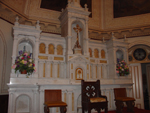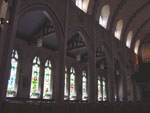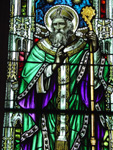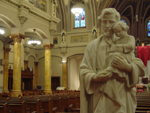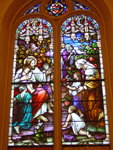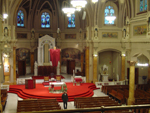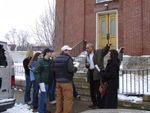
 The
class celebrated St. Patrick's day March 17, 2004 with a visit to
19th-century immigrant parishes in the city. First was St. John's
Catholic Church, 44 Temple Street, founded in 1834 by Rev. James Fitton
who also founded Holy Cross College. The Greek Revival brick church
dates from 1845, the only surviving church in this style in the city.
A Boston architect, Patrick W. Ford, provided the plans. The church
was made possible only through the purchase of land by Worcester Protestants
which was then transferred to Fr. Fitton. The interior of the church
shows the same sober ornamentation as the exterior and the altar uses
columns and pilasters in the Greek
Revival style, then the dominant style in the Worcester.
The
class celebrated St. Patrick's day March 17, 2004 with a visit to
19th-century immigrant parishes in the city. First was St. John's
Catholic Church, 44 Temple Street, founded in 1834 by Rev. James Fitton
who also founded Holy Cross College. The Greek Revival brick church
dates from 1845, the only surviving church in this style in the city.
A Boston architect, Patrick W. Ford, provided the plans. The church
was made possible only through the purchase of land by Worcester Protestants
which was then transferred to Fr. Fitton. The interior of the church
shows the same sober ornamentation as the exterior and the altar uses
columns and pilasters in the Greek
Revival style, then the dominant style in the Worcester.
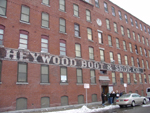 The
class also viewed factory buildings that once provided employment
for the Irish immigrants in the Green Island part of the city. The
solid mass of the Heywood Boot & Shoe Company is typical of the
workplaces experienced by the new arrivals.
The
class also viewed factory buildings that once provided employment
for the Irish immigrants in the Green Island part of the city. The
solid mass of the Heywood Boot & Shoe Company is typical of the
workplaces experienced by the new arrivals. 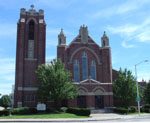 Later
these immigrants began to purchase homes in higher elevations, moving
up to the hill areas where St.
Stephens's church
was founded in 1887. St. Stephens's present structure dates from 1916,
showing a design influenced by both pointed (Gothic) and round-arched
(Romanesque) styles. A series of stained glass windows of standing
saints under architectural canopies lines both sides of the church.
The dedication plates include family names such as Boyle, O'Connor,
Hogan, Fleming, Butler, O'Neil, Sullivan, O'Toole, and FitzPatrick.
St. Patrick, patron saint of Ireland, appears as a bishop in a green
robe.
Later
these immigrants began to purchase homes in higher elevations, moving
up to the hill areas where St.
Stephens's church
was founded in 1887. St. Stephens's present structure dates from 1916,
showing a design influenced by both pointed (Gothic) and round-arched
(Romanesque) styles. A series of stained glass windows of standing
saints under architectural canopies lines both sides of the church.
The dedication plates include family names such as Boyle, O'Connor,
Hogan, Fleming, Butler, O'Neil, Sullivan, O'Toole, and FitzPatrick.
St. Patrick, patron saint of Ireland, appears as a bishop in a green
robe.
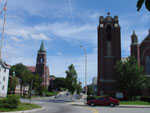 Just
across the street, St.
Joseph's church
is a testimonial to another language group. Franco-Canadians were
Worcester's second largest Catholic immigrant group.
Just
across the street, St.
Joseph's church
is a testimonial to another language group. Franco-Canadians were
Worcester's second largest Catholic immigrant group. 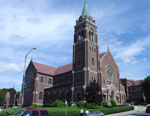 They
founded the church in 1886 and the large elaborate building was dedicated
in 1928. It was flanked by a school where instruction was in French,
similar to the French-speaking church of the Holy
Name of Jesus in Main South. A statue of St. Joseph carrying the
Christ Child demonstrates the extensive use of marble within St. Joseph's.
The windows of the church were produced by the Von Gerichten Studios,
that operated studios in Cincinnati and Munich, and are vividly pictorial.
Depicting
the Life of Christ, they exemplify the so-called "Munich"
style popular with Catholics at the time. The window of Christ Welcoming
the Little Children shows the combination of realism and detail that
had wide appeal.
They
founded the church in 1886 and the large elaborate building was dedicated
in 1928. It was flanked by a school where instruction was in French,
similar to the French-speaking church of the Holy
Name of Jesus in Main South. A statue of St. Joseph carrying the
Christ Child demonstrates the extensive use of marble within St. Joseph's.
The windows of the church were produced by the Von Gerichten Studios,
that operated studios in Cincinnati and Munich, and are vividly pictorial.
Depicting
the Life of Christ, they exemplify the so-called "Munich"
style popular with Catholics at the time. The window of Christ Welcoming
the Little Children shows the combination of realism and detail that
had wide appeal.

The class celebrated St. Patrick's day March 17, 2004 with a visit to 19th-century immigrant parishes in the city. First was St. John's Catholic Church, 44 Temple Street, founded in 1834 by Rev. James Fitton who also founded Holy Cross College. The Greek Revival brick church dates from 1845, the only surviving church in this style in the city. A Boston architect, Patrick W. Ford, provided the plans. The church was made possible only through the purchase of land by Worcester Protestants which was then transferred to Fr. Fitton. The interior of the church shows the same sober ornamentation as the exterior and the altar uses columns and pilasters in the Greek Revival style, then the dominant style in the Worcester.
The class also viewed factory buildings that once provided employment for the Irish immigrants in the Green Island part of the city. The solid mass of the Heywood Boot & Shoe Company is typical of the workplaces experienced by the new arrivals.
Later these immigrants began to purchase homes in higher elevations, moving up to the hill areas where St. Stephens's church was founded in 1887. St. Stephens's present structure dates from 1916, showing a design influenced by both pointed (Gothic) and round-arched (Romanesque) styles. A series of stained glass windows of standing saints under architectural canopies lines both sides of the church. The dedication plates include family names such as Boyle, O'Connor, Hogan, Fleming, Butler, O'Neil, Sullivan, O'Toole, and FitzPatrick. St. Patrick, patron saint of Ireland, appears as a bishop in a green robe.
Just across the street, St. Joseph's church is a testimonial to another language group. Franco-Canadians were Worcester's second largest Catholic immigrant group.
They founded the church in 1886 and the large elaborate building was dedicated in 1928. It was flanked by a school where instruction was in French, similar to the French-speaking church of the Holy Name of Jesus in Main South. A statue of St. Joseph carrying the Christ Child demonstrates the extensive use of marble within St. Joseph's. The windows of the church were produced by the Von Gerichten Studios, that operated studios in Cincinnati and Munich, and are vividly pictorial. Depicting the Life of Christ, they exemplify the so-called "Munich" style popular with Catholics at the time. The window of Christ Welcoming the Little Children shows the combination of realism and detail that had wide appeal.


